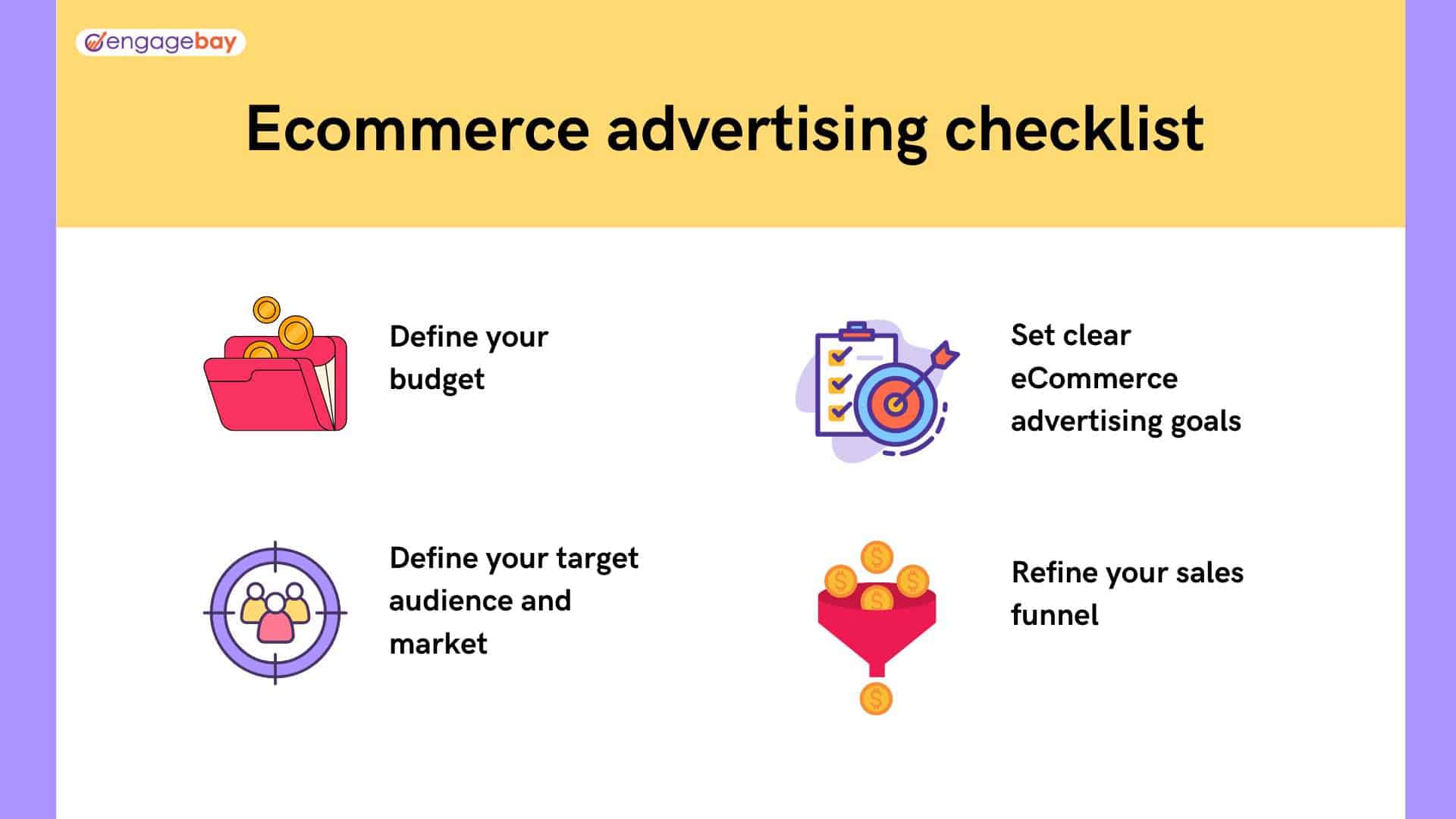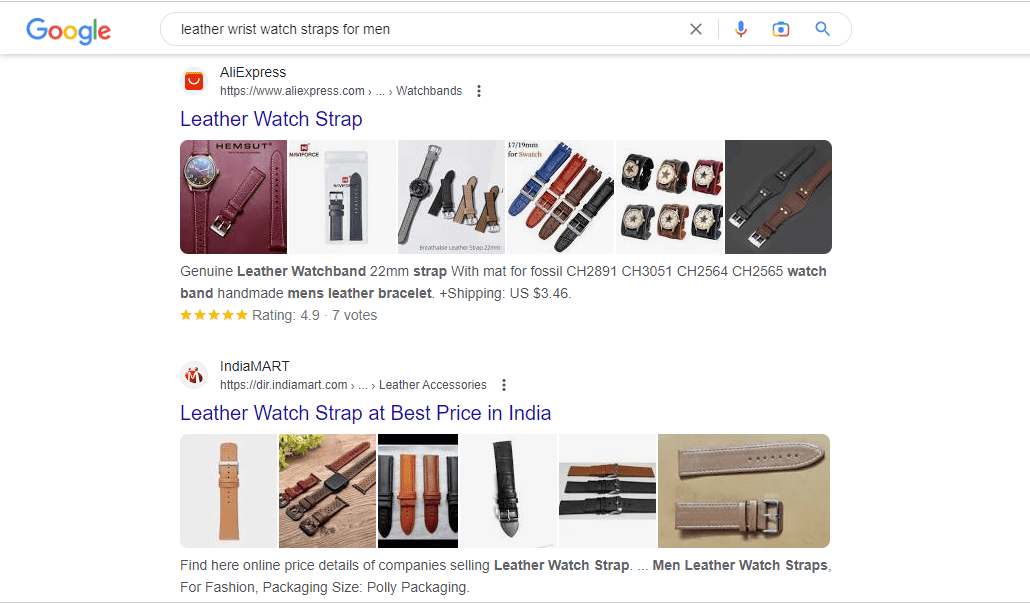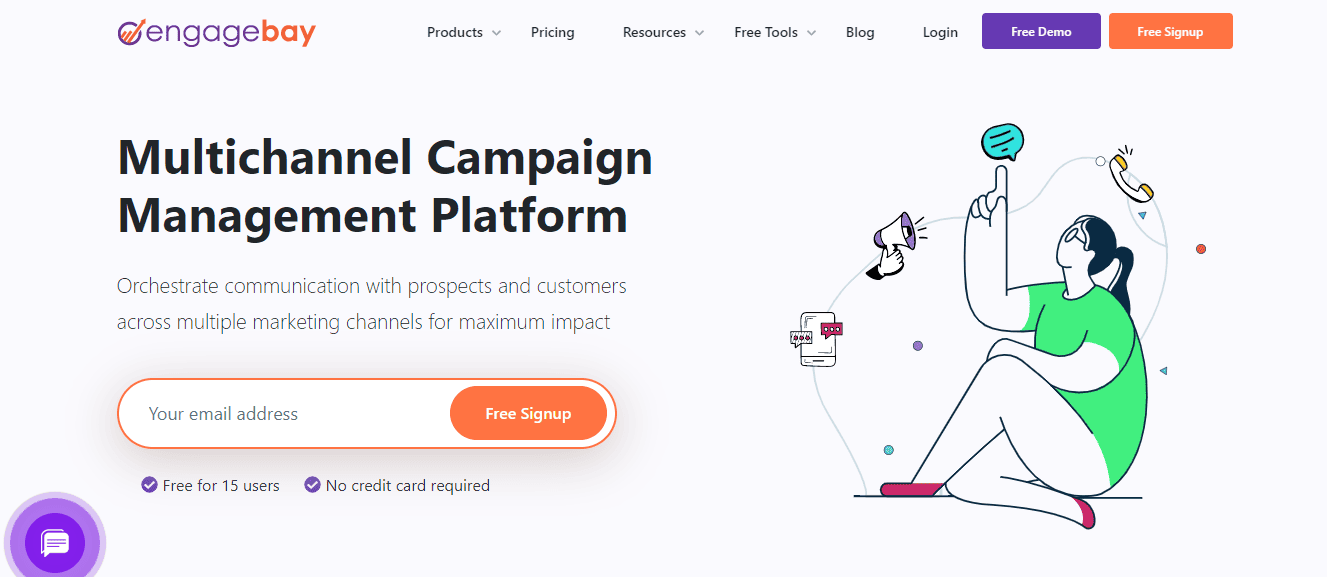With eCommerce revolutionizing the way we shop, eCommerce advertising has emerged as a cornerstone for businesses looking to expand their online presence, boost sales, and outperform competitors.
As the world becomes increasingly connected and consumers continue to embrace online shopping, eCommerce advertising should be on your radar if you want to boost sales.
However, eCommerce advertising is a sea of fast-moving strategies. As a result, you must constantly adopt, adapt, refine, and weed out what no longer works to stand out from the massive online marketing competition.
In this blog post, we’ve curated the top eCommerce advertising strategies you can implement today for spectacular growth.
Table of Contents
What is eCommerce Advertising?
At its core, eCommerce advertising is a multifaceted digital marketing approach that enables businesses to effectively promote their products or services online, fostering a seamless shopping experience for consumers.
The main objective of eCommerce advertising is to increase the visibility and reach of a business to potential customers, thereby driving traffic to the eCommerce website and boosting sales.
By combining targeted campaigns, engaging content, and optimization strategies, eCommerce advertising helps online store owners to stand out, drive sales, and achieve sustainable growth.
With eCommerce sales projected to reach $8.1 trillion in 2026, your safe bet is to invest in eCommerce advertising to get your share of the eCommerce sales pie.
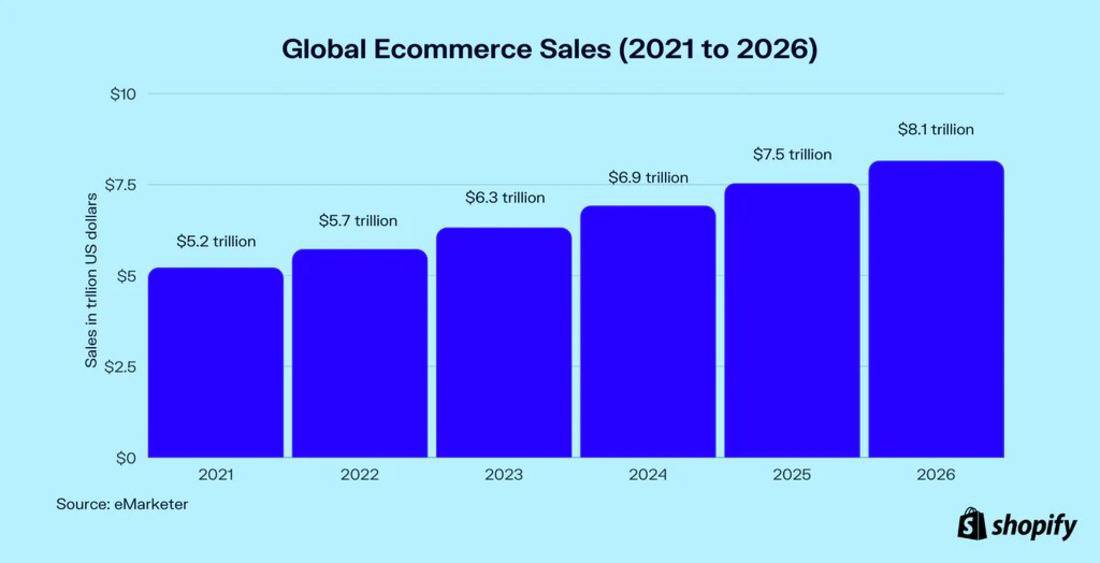
Benefits of eCommerce Advertising
eCommerce advertising costs can rack up quickly depending on your chosen marketing strategies. Still, it helps to see eCommerce advertising as an investment for your business success rather than an expense. Here are six benefits of investing in eCommerce advertising.
- eCommerce advertising can be tailored to support various customer journey stages, from awareness and consideration to purchase and post-purchase engagement. This helps your business maintain a strong presence throughout the entire sales funnel, nurturing leads and turning one-time buyers into repeat customers.
- It allows you to optimize your ad spend by focusing on channels that yield the highest conversion rates, helping your eCommerce business achieve its objectives while staying within budget constraints.
- It helps businesses target their campaigns based on demographic, geographic, and behavioral factors, ensuring your marketing efforts generate maximum return on investment. Simply put, it means you reach the right people at the right time, leading to higher conversion rates and more sales.
- It’s a great way to engage with your target audience, ensuring your products and services remain at the forefront of consumer consciousness.
- Through targeted marketing, eCommerce advertising can transform passive browsers into active buyers, driving sales and bolstering the bottom line. Also, it allows your business to reach a wider audience, increase sales, and build brand awareness.
- By consistently promoting products or services through various digital channels, businesses can build their brand and establish themselves as leaders in their industry. This is particularly important for new eCommerce store owners looking to establish themselves in a crowded marketplace.
Raed also: 6 High-Impact eCommerce Marketing Strategies to Try Now
Digital Marketing Checklist to Win at eCommerce Advertising
Having the following in place is best to get the most out of your eCommerce advertising efforts.
1. Define your budget
Setting a budget before advertising allows you to create a more effective and efficient advertising strategy that ensures maximum ROI and minimal financial strain on your business.
For example, if you are a small eCommerce store owner, rather than go for PPC advertising that costs $1,000-$10,000 on average, you can opt-in for SMS marketing on EngageBay (on EngageBay, there’s a perfect solution for every budget!)
In addition, having a budget means staying within your means and avoiding financial strain. It also helps prioritize your advertising efforts and allocate funds to the most effective channels. By defining your budget ahead of time, you can also evaluate the ROI of different eCommerce advertising options to determine which ones are worth investing in.
2. Define your target audience and market
Because eCommerce advertising is about reaching the right people at the right time with the right message, defining your target audience is crucial before deciding on an eCommerce advertising option.
With a clear understanding of your target audience, you can create effective advertising campaigns that resonate with them. Defining your target audience involves understanding their demographics, interests, behaviors, and pain points. This information helps you to create highly targeted campaigns that speak directly to your audience, increasing the chances of conversion.
Suppose you sell high-performance footwear; your target audience would be athletes and sports people. If you sell kitchen equipment and utensils, your target audience would be moms or caterers. Knowing your audience can tailor your eCommerce strategy to meet their needs and expectations.
Read also: Predictive Analytics for eCommerce Emails: Beginner’s Guide
3. Set clear eCommerce advertising goals
With clearly defined goals, it can be easier to determine the right advertising approach. The primary goals of eCommerce advertising are to drive sales and increase revenue.
However, other goals may mean success for your online store, such as increasing brand awareness or boosting customer engagement. In that case, you should consider social media marketing or SMS marketing. Conversely, consider retargeting or paid ads if you want to drive sales.
4. Refine your sales funnel
A well-optimized funnel can increase your chances of converting leads into customers and improve your return on investment (ROI) from advertising spend. You can refine your sales funnel by doing the following:
- Analyzing all the touchpoints in your funnel, from lead generation to sales conversion.
- Identify any bottlenecks or areas of improvement and make necessary adjustments.
- Implement A/B testing to experiment with different messaging and calls to action.
- Make sure your website is user-friendly, and the checkout process is streamlined.
By refining your funnel before implementing eCommerce advertising, you can ensure that your advertising spends are used effectively and maximize your ROI. Now let’s discuss the eCommerce advertising strategy in detail.
Here’s a graphic representation of the eCommerce advertising checklist:
Read also: eCommerce Metrics Made Easy: How to Drive Growth
7 eCommerce Advertising Strategies for Business Growth
Let’s get to the meat of the matter now.
1. Increase eCommerce sales with retargeting
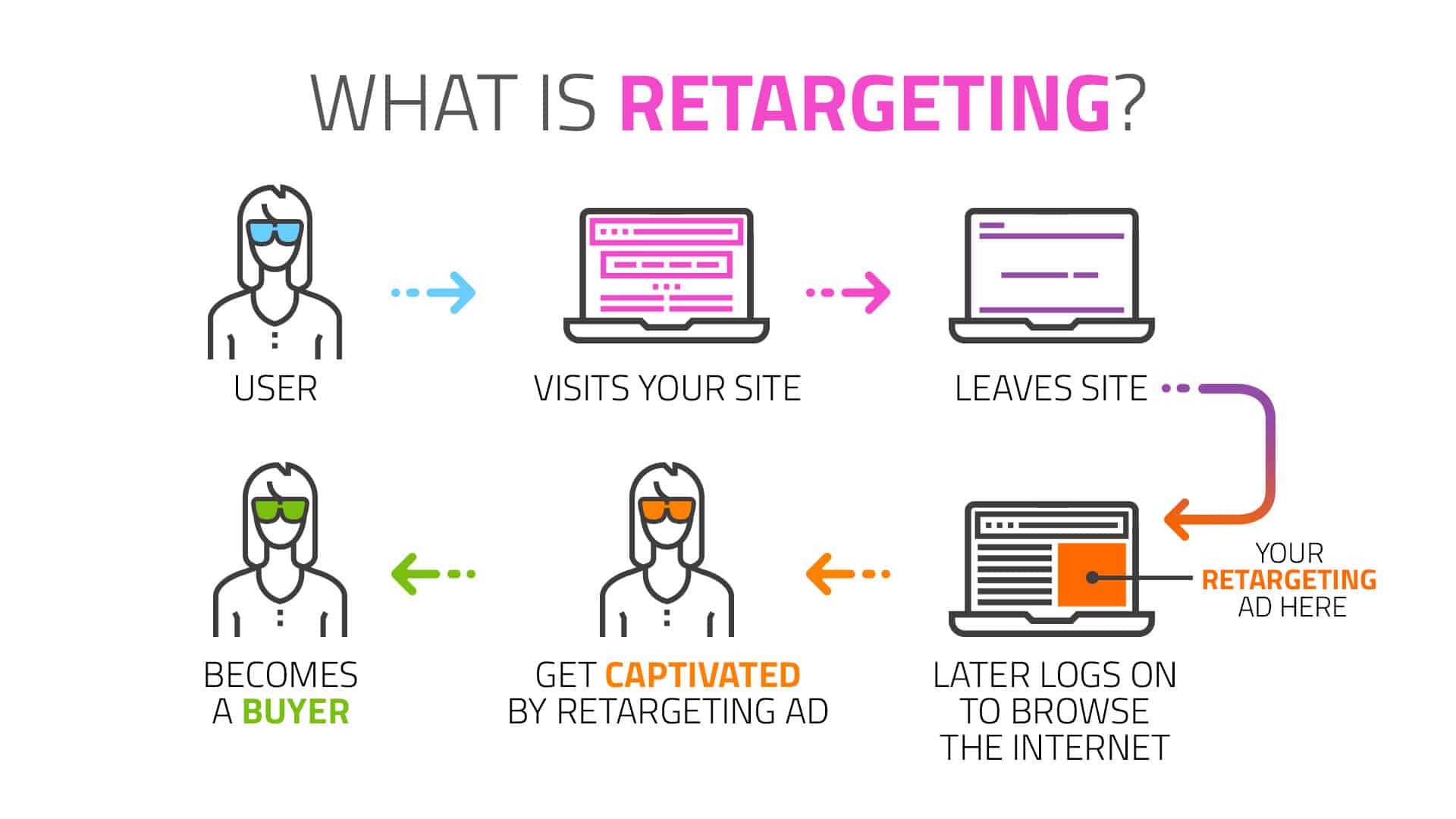
A survey shows that 75% of visitors who abandon their cart want to return later. The problem is they may be unable to remember the website they shopped from. That’s where retargeting comes in.
Retargeting is an advertising strategy that targets potential customers who have already shown an interest in a particular product or service. This strategy aims to bring back those visitors who have left the website without making a purchase.
It works by placing a cookie on the visitor’s browser when they visit a website. The cookie follows visitors as they browse other websites and display relevant ads. These can be banner ads, social media ads, or email marketing campaigns.
Moreover, retargeting also helps in creating brand awareness and improving customer engagement. By showing ads to people familiar with the brand, retargeting helps strengthen the brand’s image.
With only 2% of website visitors purchasing their first visit, retargeting is a perfect way to increase conversion rates and Return On Advertising Spend (ROAS).
Consider retargeting especially when you have a lot of eCommerce website visitors who aren’t converting.
Read also: Dental Ads That’ll Make You Laugh 😂
2. Incorporate SMS texting into your email marketing strategy
The inbox of many customers buzzes non-stop with marketing emails that may get opened on time, especially during the Holidays.
Therefore, it’s best to integrate SMS marketing into your email marketing strategy for better deliverability. SMS marketing shines with an open rate of 98% and a 36% click-through rate, making it a reliable way to reach your customers quickly and effectively.
In addition, SMS marketing has an ROI of $77 for every $1 spent (more reasons you should try it out.) By sending personalized text messages to your customers, you can keep them updated about your latest offers, promotions, and product launches in real-time, which increases sales and customer loyalty.
A popular example of businesses benefiting from the effectiveness of SMS marketing is Starbucks. The coffee giant recorded a 75% increase in mobile sales and increased customer engagement after implementing their SMS marketing strategy.
You must have a clear strategy to use SMS marketing effectively in eCommerce advertising. Start by building a targeted list of subscribers who have opted-in to receive text messages from your brand. You can do this by offering incentives such as discounts or freebies to customers who sign up for your SMS marketing list.
Once you have a captive audience, crafting compelling messages relevant to your customers is essential. Use personalized language and targeted offers to make your text messages stand out. Ensure your messages are short and with a clear call to action, as most people only have a few seconds to read a text message.
If you’re looking for the best SMS marketing platform, try EngageBay for free. On EngageBay, you can track performance, personalize, automate your SMS campaigns, segment your audience, and create marketing workflows easily.
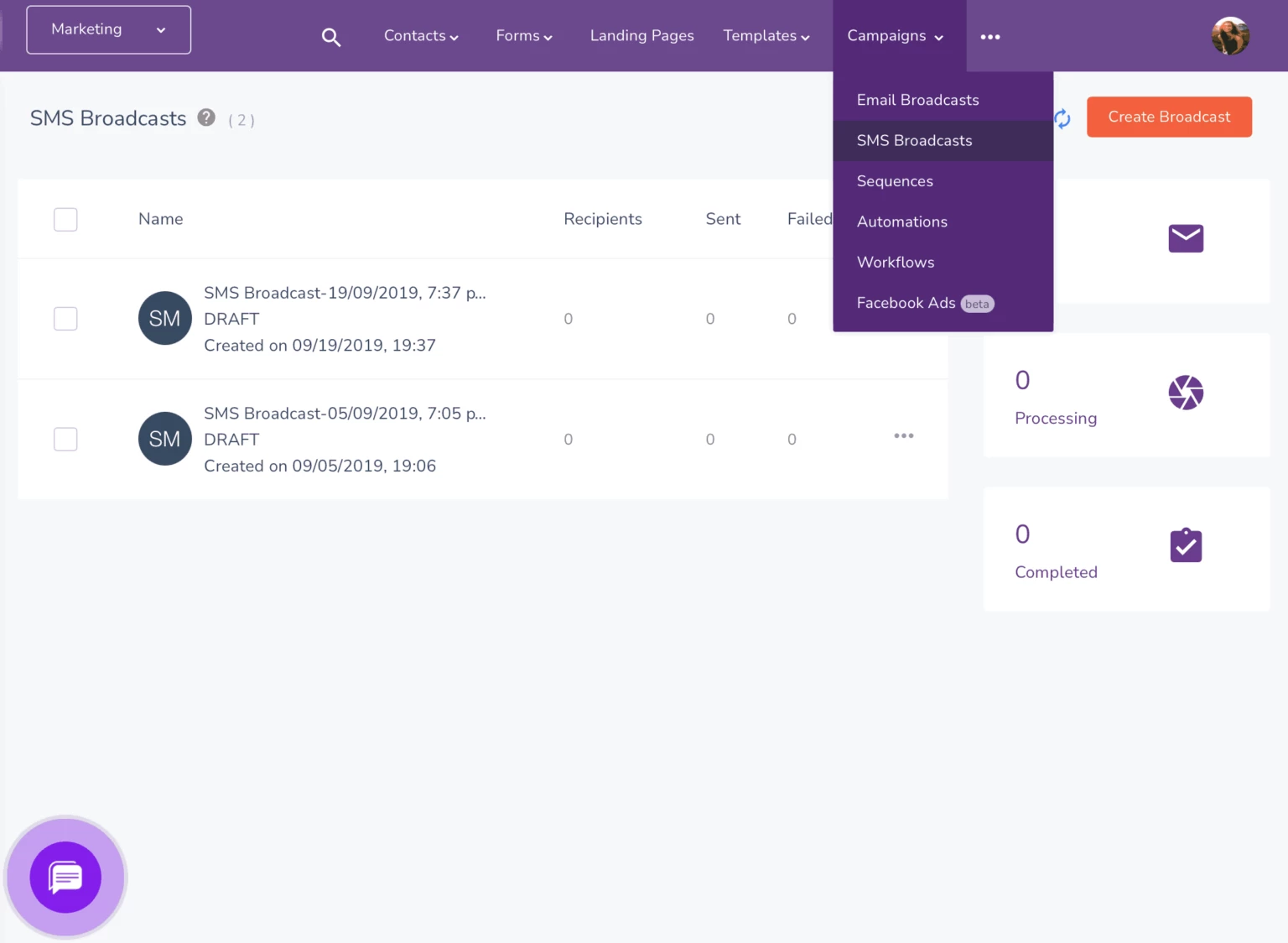
3. Increase visibility and drive conversion with PPC advertising
Pay-per-click (PPC) advertising is a great way to get your products in front of potential customers with high purchase intent and drive conversions. One of the most significant benefits of PPC advertising is reaching a highly targeted audience.
You can specify your target audience’s demographics, location, and interests, ensuring that your ads are only shown to people most likely to be interested in your products. This means you’re not wasting money on advertising to people who aren’t expected to purchase.
PPC advertising is also highly measurable, allowing you to track your ROI and adjust your campaigns based on data. For example, you can see which ads drive the most clicks and conversions and adjust your bidding strategy accordingly. This level of control enables you to optimize your eCommerce advertising campaigns for maximum ROAS.
In addition, it works to add customer ratings and reviews to your ads, like in the screenshot below, for better conversions.
With a 200% ROI ($2 return for every $1 spent) and 50% more likely to convert than organic traffic, PPC advertising is definitely worth implementing.
The downside, however, is PPC ads cost $2.59 per click and $3.12 per 1,000 impressions, which can sum up to $10,000-$500,000 for an effective campaign making it a high-budget eCommerce advertising option and unfit for store owners on a shoestring budget.
Read also: 19 eCommerce Best Practices to Win Customer Confidence
4. Build brand trust with referral marketing
Referral marketing incentivizes customers to refer their friends and family to the brand, typically through discounts or other rewards. By doing so, you can tap into the power of word-of-mouth marketing, one of the most effective forms of advertising. Here are some referral marketing statistics.
- Word-of-mouth improves marketing effectiveness by 54%
- 92% of consumers trust referrals from people they know
- Customers acquired through Referrals spend 200% more than average customers
- People are four times more likely to buy when referred by a friend
The main benefit of referral marketing is that it helps build brand trust. When customers refer their friends and family to a brand, they are essentially vouching for the quality of the product or service. This can be particularly powerful in eCommerce, where customers may hesitate to purchase from an unfamiliar brand.
By leveraging their existing customer base, eCommerce brands can quickly build a reputation and establish trust with potential customers. Additionally, referral marketing can be highly cost-effective (depending on your chosen incentives).
Referral marketing can be relatively inexpensive compared to other forms of advertising, such as paid search or social media advertising.
This makes it an attractive option for eCommerce brands of all sizes, particularly those with limited budgets. The trick, however, is to make the reward for customer referral more mouth-watering so your customers are more willing to refer your product.
Read also: 8 Great Business One-Pager Examples & How to Create Yours
5. Increase website traffic and sales through SEO

Search engine optimization is an oldie but goldie eCommerce advertising strategy. SEO helps you attract high-quality leads and potential customers. By optimizing your website for relevant keywords, you can target users actively searching for products or services related to your business.
This means that you are more likely to attract users who are interested in what you offer and more likely to convert into paying customers.
In the context of eCommerce advertising strategy, SEO plays a vital role in driving traffic and sales to an online store. By optimizing product and category pages for relevant keywords, eCommerce businesses can rank higher in search engine results and attract more potential customers to their websites.
In addition, optimizing a website for local search helps you target customers in specific geographic locations and drive more foot traffic to your physical stores. SEO is also a cost-effective way to drive traffic to your website.
Unlike paid advertising, which requires a significant investment, SEO can be done with minimal investment and deliver long-term results.
Read also: The Advantages and Disadvantages of eCommerce
6. Increase eCommerce profit through upselling and cross-selling
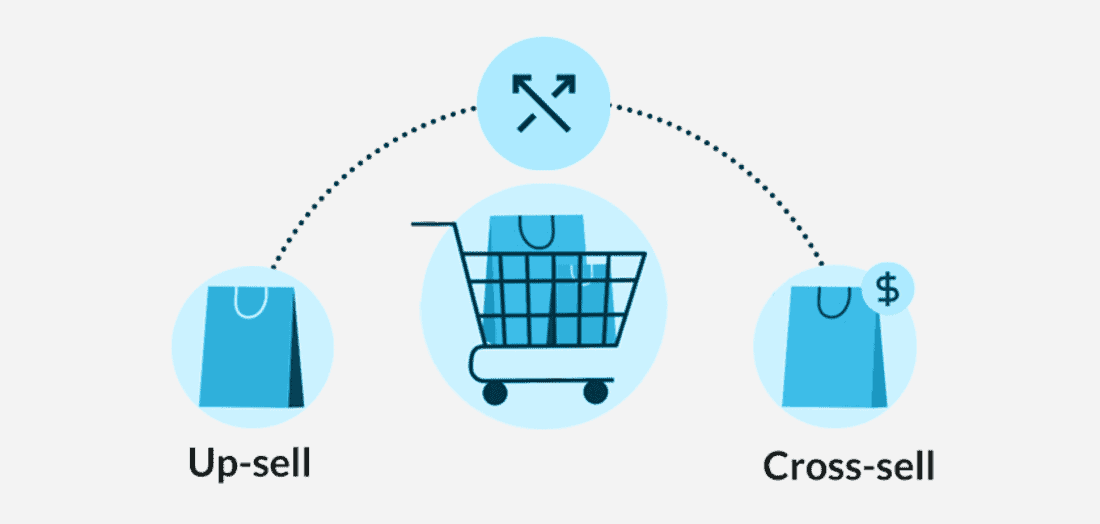
Upselling involves offering a product a higher-end or premium version to a customer who has already shown an interest in a similar but lower-end product. On the other hand, cross-selling involves offering complementary products that go hand-in-hand with the customer’s initial purchase.
This technique helps you increase your eCommerce revenue and customer lifetime value. For example, your eCommerce store can boost its average order value and increase profits by offering customers more options and showing them the importance of upgrading to a higher-end product.
Additionally, cross-selling helps create a more personalized shopping experience for customers, leading to increased loyalty and repeat purchases. When combined with SMS marketing, upselling and cross-selling have a conversion rate as high as 23%.
To effectively incorporate upselling and cross-selling into your eCommerce advertising strategy, it’s essential to understand your customers’ needs and preferences.
By analyzing their purchase history, browsing behavior, and demographics, you can identify opportunities to offer personalized product recommendations and promotions.
It’s also essential to ensure that your product recommendations are relevant and add value to the customer’s shopping experience rather than being pushy or salesy.
Read also: Top 10 C2C Marketplaces to Help You Sell Quickly
7. Implement omnichannel marketing to enhance customer reach

The use of omnichannel marketing enhances the effectiveness of retargeting efforts. Omnichannel marketing utilizes a variety of channels to provide a seamless experience for customers, reflecting their typical online behavior of using multiple channels for different purposes throughout the day.
This approach involves reaching customers through multiple channels, including social media, email, SMS, and in-store experiences, to provide a seamless and personalized shopping experience. By leveraging customer data and insights, businesses can create targeted campaigns that resonate with their audience and drive sales across all channels.
Omnichannel marketing mirrors how customers navigate and shop online: they rely on something other than emails, Facebook, Instagram, or SMS. Instead, they utilize all of them, possibly for various purposes or at different times throughout the day.
For instance, rather than distributing identical messages across all platforms, if a customer purchases after receiving an abandoned cart SMS, the subsequent email would be a post-purchase message, not another abandoned cart reminder.
Another scenario might involve a customer leaving their cart on the website and later encountering a retargeting advertisement on Facebook. With so many options for shopping and browsing online, creating a cohesive and consistent experience across all touchpoints is essential.
By using a combination of channels, you can build brand awareness, engage with customers, and drive conversions at every stage of the customer journey. Omnichannel marketing has been made easy on EngageBay.
Read also: How to Start an Online Clothing Store in 2025
In Conclusion
Are these the end-all, be-all of eCommerce advertising? Nope. But they are an essential cog in the wheel for all e-preneurs to consider starting from.
Suppose you are a small eCommerce store owner or a startup with a slim budget. You should try cost-effective eCommerce advertising strategies like referral or SMS marketing.
Conversely, opt for PPC advertising if you have a high-end budget.
Try EngageBay to scale up your marketing, sales, and automation efforts on a single platform today. See what a customer has to say about EngageBay:

